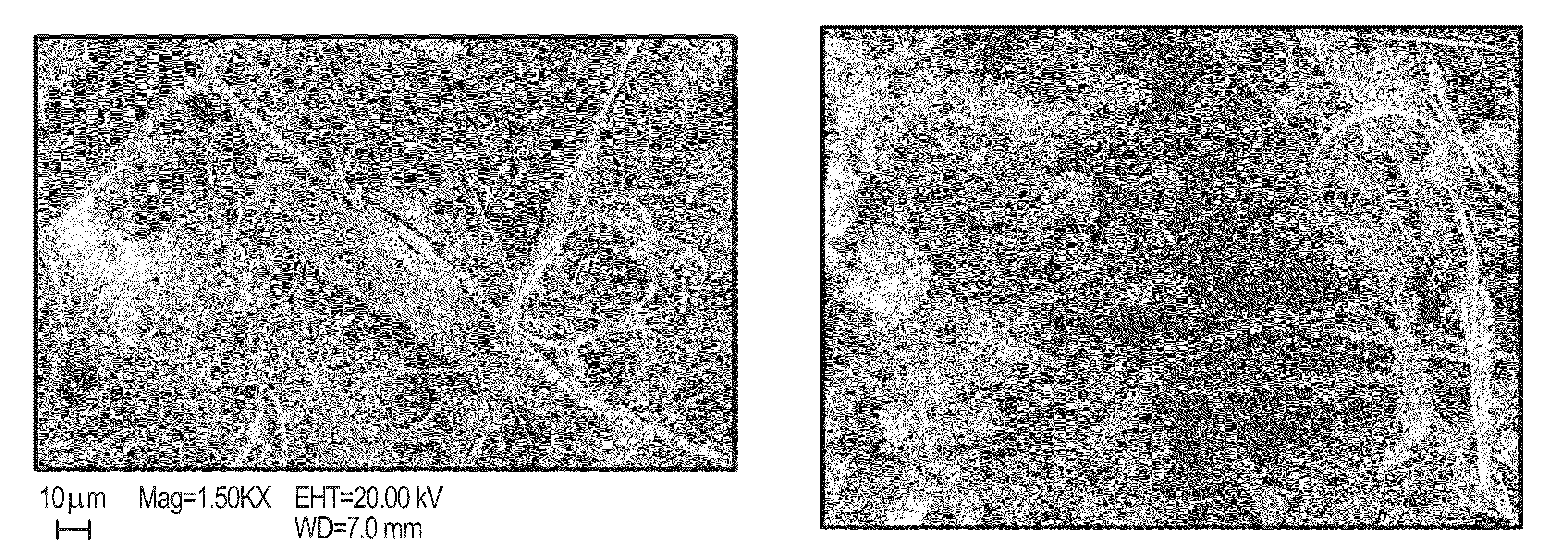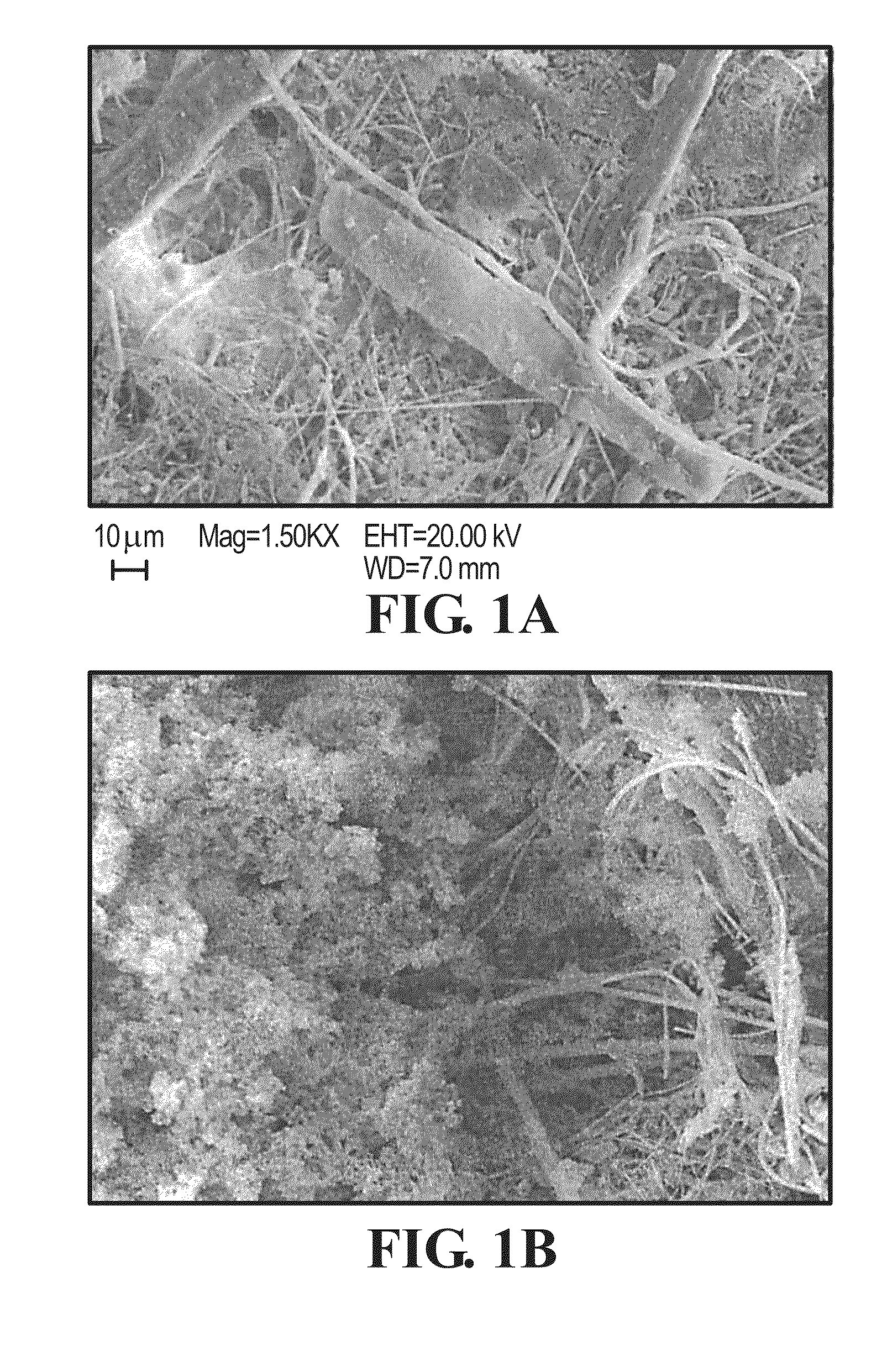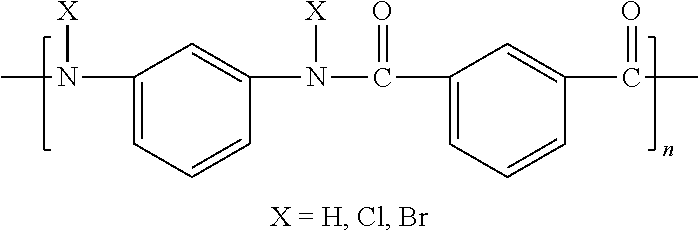Disinfecting and detoxifying meta-aramid particles
a technology of meta-aramid particles and meta-halamine, which is applied in the direction of dyeing process, water/sewage treatment by oxidation, weaving, etc., can solve the problems of reducing loading capacity, lack of resistance to ultraviolet photodegradation, and oxidative halogen loading capacity of n-halamine polymer coatings, so as to prolong antimicrobial and detoxification activity, less photodegradation, and the effect of reducing the cos
- Summary
- Abstract
- Description
- Claims
- Application Information
AI Technical Summary
Benefits of technology
Problems solved by technology
Method used
Image
Examples
example 1
Preparation of Unhalogenated and Chlorinated Porous Nomex Particles
[0035]50 grams of an ionic liquid, 1-buthyl-3-methyl-imidazolium chloride (Aldrich Chemicals Inc.) were added to a round bottom flask containing 0.62 gram of Nomex™ (DuPont, Corp.) fibers which were cut into small pieces to improve mixing. The solution was stirred with a mechanic stirrer at 80° C. for 72 hours until the fiber was completely dissolved. The solution was withdrawn with a syringe and precipitated in 200 mL of ethanol accompanied by vigorous agitation using a household blender. A uniform hazy suspension (ethanol, aramid, and ionic liquid) was produced. The cloudy suspension was filtered using a filter paper and then washed with distilled water and dried in air. The diameters of the resulting porous Nomex particles were between 1 and 2 μm.
[0036]The particles were then chlorinated using a commercial household hypochlorite bleach solution diluted 9 / 1 with tap water. The pH was adjusted to 7 using 6 N hydroch...
example 2
Preparation of Unhalogenated and Chlorinated Porous Nomex / Cellulose Particles
[0038]24 grams of an ionic liquid (1-buthyl-3-methyl-imidazolium chloride), were added to a flask containing 0.5 g Nomex™ aramid fibers which were cut into small pieces to improve mixing. They were stirred in a centrifugal mixer at 2500 rpm for about 20 minutes until the fiber was soaked by the ionic liquid. Then 0.5 grams of ground bleached cotton cellulose was added to the above solution, and mixing was continued for 1 hour. The solution was heated at 80° C. for 1 hour to lower the solution viscosity. Mixing and heating were repeated alternately to complete dissolution. The above solution was subsequently diluted by 3 / 1 with additional solvent.
[0039]The solution then was withdrawn with a syringe and injected into 200 mL of ethanol while undergoing vigorous agitation with a household blender. A uniform hazy suspension (ethanol, aramid, cellulose, and ionic liquid) was observed. Upon standing, a cloudy aggl...
example 3
Preparation of Unhalogenated and Chlorinated Permeable Nomex / Cellulose Blended Films from Particles
[0041]24 grams of an ionic liquid (1-butyl-3-methylimidazolium chloride) were added to a flask containing 0.5 gram of Nomex™ fibers which were cut into small pieces to improve mixing. The solution was stirred in a centrifugal mixer at 2500 rpm for about 20 minutes until the fiber was well dispersed. Then 0.5 gram of ground bleached cotton cellulose was added to the above solution, and mixing and heating to 80° C. were repeated alternately to complete dissolution. To lower the solution viscosity, it was diluted 3 / 1 with additional solvent.
[0042]The solution was withdrawn with a syringe and injected into 200 mL of ethanol during vigorous agitation effected by a household blender. A uniform hazy suspension (ethanol, aramid, cellulose, and ionic liquid) was produced. Upon standing, a cloudy agglomeration began to settle from the suspension. The cloudy suspension was stirred and filtered th...
PUM
| Property | Measurement | Unit |
|---|---|---|
| diameter | aaaaa | aaaaa |
| pH | aaaaa | aaaaa |
| temperatures | aaaaa | aaaaa |
Abstract
Description
Claims
Application Information
 Login to View More
Login to View More - R&D
- Intellectual Property
- Life Sciences
- Materials
- Tech Scout
- Unparalleled Data Quality
- Higher Quality Content
- 60% Fewer Hallucinations
Browse by: Latest US Patents, China's latest patents, Technical Efficacy Thesaurus, Application Domain, Technology Topic, Popular Technical Reports.
© 2025 PatSnap. All rights reserved.Legal|Privacy policy|Modern Slavery Act Transparency Statement|Sitemap|About US| Contact US: help@patsnap.com



